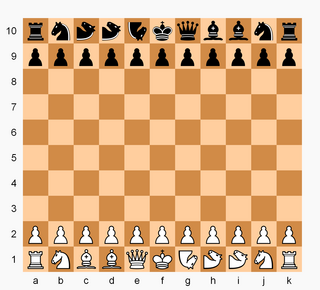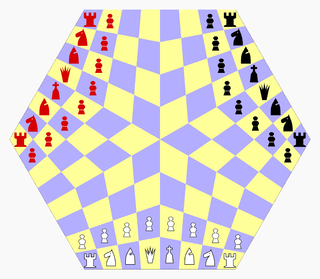Losing chess is one of the most popular chess variants. The objective of each player is to lose all of their pieces or be stalemated, that is, a misère version. In some variations, a player may also win by checkmating or by being checkmated.

Alice chess is a chess variant invented in 1953 by V. R. Parton which employs two chessboards rather than one, and a slight alteration to the standard rules of chess. The game is named after the main character "Alice" in Lewis Carroll's work Through the Looking-Glass, where transport through the mirror into an alternative world is portrayed on the chessboards by the after-move transfer of chess pieces between boards A and B.
Grand Chess is a large-board chess variant invented by Dutch games designer Christian Freeling in 1984. It is played on a 10×10 board, with each side having two additional pawns and two new pieces: the marshal and the cardinal.
Progressive chess is a chess variant in which players, rather than just making one move per turn, play progressively longer series of moves. The game starts with White making one move, then Black makes two consecutive moves, White replies with three, Black makes four and so on. Progressive chess can be combined with other variants; for example, when Circe chess is played as a game, it is usually progressively. Progressive chess is considered particularly apt for playing correspondence chess using mail or some other slow medium, because of the relatively small number of moves in a typical game.
Martian Chess is an abstract strategy game for two or four players invented by Andrew Looney in 1999. It is played with Icehouse pyramids on a chessboard. To play with a number of players other than two or four, a non-Euclidean surface can be tiled to produce a board of the required size, allowing up to six players.
Extinction chess is a chess variant invented by R. Wayne Schmittberger, editor of Games magazine, in 1985. Instead of checkmate as the winning condition, the object of the game is the elimination of all of a particular type of piece of the opponent. In other words, the objective is any of the following:
Marseillais chess is a chess variant in which each player moves twice per turn. The rules of the game were first published in Marseillais local newspaper Le Soleil in 1925. The variant became quite popular in the late 1930s with such chess grandmasters as Alexander Alekhine, Richard Réti, Eugene Znosko-Borovsky, and André Chéron playing it.
Kriegspiel is a chess variant invented by Henry Michael Temple in 1899 and based upon the original Kriegsspiel developed by Georg von Reiswitz in 1812. In this game, each player can see their own pieces but not those of their opponent. For this reason, it is necessary to have a third person act as an umpire, with full information about the progress of the game. Players attempt to move on their turns, and the umpire declares their attempts 'legal' or 'illegal'. If the move is illegal, the player tries again; if it is legal, that move stands. Each player is given information about checks and captures. They may also ask the umpire if there are any legal captures with a pawn. Since the position of the opponent's pieces is unknown, Kriegspiel is a game of imperfect information.
David Brine Pritchard was a British chess player, chess writer and indoor games consultant. He gained pre-eminence as an indoor games and mind sports consultant, a role that he in effect created. A natural games player, it was to him that inventors or publishers would turn to organise a championship of a new game, write about it or generally promote it.

Cubic chess is a chess variant invented by Vladimír Pribylinec beginning with an early version in 1977. The game substitutes cubes for the chess pieces, where four of the faces of each cube display a different chess piece, the two other faces are blank and are orientated to the players. This provides an efficient means to change a piece's type. Kings and queens have unique cubes containing only their symbol, effectively behaving as normal.

2000 A.D. is a chess variant created by V. R. Parton which employs fairy chess pieces on a 10×10 board. Parton published the variant in his 1972 monograph My Game for 2000 A.D. and After.

Wildebeest chess is a chess variant created by R. Wayne Schmittberger in 1987. The Wildebeest board is 11×10 squares. Besides the standard chess pieces, each side has two camels and one "wildebeest" - a piece which may move as either a camel or a knight.

Dragonfly is a chess variant invented by Christian Freeling in 1983. There are no queens, and a captured bishop, knight, or rook becomes the property of the capturer, who may play it as their own on a turn to any open square. The board is 7×7 squares, or alternatively a 61-cell hexagon with two additional pawns per side.

Rhombic chess is a chess variant for two players created by Tony Paletta in 1980. The gameboard has an overall hexagonal shape and comprises 72 rhombi in three alternating colors. Each player commands a full set of standard chess pieces.

Three-man chess is a chess variant for three players invented by George R. Dekle Sr. in 1984. The game is played on a hexagonal board comprising 96 quadrilateral cells. Each player controls a standard army of chess pieces.

Hostage chess is a chess variant invented by John A. Leslie in 1997. Captured pieces are not eliminated from the game but can reenter active play through drops, similar to shogi. Unlike shogi, the piece a player may drop is one of their own pieces previously captured by the opponent. In exchange, the player returns a previously captured enemy piece which the opponent may drop on a future turn. This is the characteristic feature of the game.
Dynamo chess is a chess variant invented by chess problemists Hans Klüver and Peter Kahl in 1968. The invention was inspired by the closely related variant push chess, invented by Fred Galvin in 1967. The pieces, board, and starting position of Dynamo chess are the same as in orthodox chess, but captures are eliminated and enemy pieces are instead "pushed" or "pulled" off the board. On any given move, a player can make a standard move as in orthodox chess, or execute a "push move" or a "pull move". A move that is either a push move or a pull move is called a "dynamo move".
Chancellor chess is a chess variant invented by Benjamin R. Foster in 1887. It features all the regular chess pieces plus one chancellor and extra pawn per side, on a 9×9 board.
Chakra is a chess variant invented by Christian Freeling in 1980. The uniqueness of Chakra is owed to the invention of a new fairy piece named transmitter. Freeling considered an earlier version of the game as insignificant. "Then one night in the early eighties, Ed [van Zon] and I dreamed up the 'transmitter', a piece consisting of two parts called 'chakras', that would function as a 'portal' for transmitting pieces."







